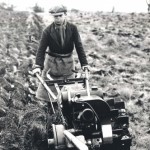Home › Forums › The Machinery Forums › Pedestrian operated machines › Trusty dog clutch shaft removal
- This topic has 4 replies, 2 voices, and was last updated 1 year, 2 months ago by
 sidevalve5.
sidevalve5.
-
AuthorPosts
-
February 27, 2024 at 10:29 am #41858
 sidevalve5Participant
sidevalve5ParticipantHi,
This is the first time I have used the forum. Have owned and been mad enough to use a Trusty for 40 years now. Use it to keep young orchard clean and for a very large veg plot. It had had a hard life on market gardens around the Vale of Evesham when I bought it. Went to get a Clifford Model A rotovator, but the chap was giving up his ground and wanted rid of the Trusty too. It had a rebuilt Model 5 Jap engine, so gave £25 for. Have kept it going over all these years, enjoyed doing the necessary work on it to keep it reliable. Have some mechanical skills, so it was never too much of a problem. Have got a whole range of other 1940’s – 1960’s walk-behind tractors and use many of them too. Those I use are: Barford Atom 15, Gravely Model L, Clifford Mk1, Colwood motorhoe, plus many others I intend to get going at some point.
Now though have become stuck for the first time. Was rolling in some grass seed last autumn went it threw the chain from the clutch dog to the left hand drive wheel. It was cause by the chainwheel nut coming loose. It bent the splined gear countershaft. It caused the dog clutches to stick open when disengaged. Managed to do a very temporary partial fix so I could finish the job. Will need the Trusty to do some ploughing when the ground dries out, decided to get the countershaft off for a full repair.
Took off the chains, the dog clutch split bearing holders from the steering levers. Got the bearing housings undone from both sides, removed the castellated nut from the right hand side. I expected to then withdraw the shaft from the left hand side so I could remove the bearing behind the castellated nut. But no go. Got a couple of chisels behind the external pulley mounting on the left hand side, but nothing is budging. Has anyone took this shaft out and if so, how did you do it. Am not sure how the pulley mount is attached to the shaft and how it is retained.
Be really pleased if someone could help. Will need to use the Trusty in a couple of weeks time. Have got a Douglas engine Trusty too, but I purchased it in bits and it would take an age to build it up again. To get such engines reliable and to pull well I usually re-ring them, hone the barrel, re-cut the valve seats and replace the condenser with a modern capacitor. Fitting the capacitor has made the greatest difference. Starting and tickover has been transformed and for only 40p a pop too.
February 27, 2024 at 12:36 pm #41859 trusty220Keymaster
trusty220KeymasterHello, Graham, thank you for taking the time to find us and ask the question.
The Trusty countershaft is reasonably easy to remove but be aware that it has probably been in position for many years, so getting it started may be a challenge! For those of you who may be reading this at a later time I will go through the sequence of screws and bolts from the beginning.
To start with, remove the circular casting on the right hand side of the transmission case; it has four bolts equi-spaced around it’s perimeter and the bolt heads are not captive so you will need a spanner or socket inserted through the chain sprocket inside the transmission case to stop the bolts spinning as you undo the nuts on the outside. This casting holds the countershaft bearing in position, so a lever behind it will normally start it moving but it shouldn’t fall off easily. Once off, this will expose a castellated nut which holds the bearing onto the shaft; remove the split pin and undo the nut, then use a bearing puller to remove the bearing.
This is the bit that most people miss- look inside the transmission case at the countershaft chainwheel that drives the left hand wheel. Wipe off all the gunge and underneath you should find a piece of locking wire wrapped around the parallel part of the sprocket; snip the wire off and rotate the sprocket and you should find a countersunk screw with a slotted head that the wire was holding in place- undo the screw and you will find it has a spigot on the end that locates in a hole in the phosphor bronze bush in the centre of the sprocket.
Once all of these are undone it should just be a matter of striking it with a hammer from the right hand side, but find something that will fit over the thread so that your hammer blows will be acting on the shoulder at the base of the thread. Alternatively you could try wedging it underneath the pulley flange on the left hand side- either way will work.
Some time last year somebody was advertising new old stock Trusty countershafts on that well known auction site; does anybody know who it was? I think they were located in Nottinghamshire.
February 29, 2024 at 12:11 pm #41861 sidevalve5Participant
sidevalve5ParticipantDear Geoff,
Many thanks for your invaluable advice. Found that my machine did not have a screw with locking wire over the slot. But a spring clip with a pin that would locate the sprocket bush. The flat spring clip goes about two thirds around the sprocket hub. Still have a problem though because the clip appears twisted and no matter what I did I could not get it to clear the bearing housing. Have made a special tool, a piece of steel with a slot in it the same size as the hub to slide in between the bearing housing and the clip. So the clip should straighten enough so I can push it off the hub. There is very little clearance between the housing face and the clip, so made the tool out of the thinnest steel plate I could find. A paint tin lid. But think it will not be strong enough, but have not tried it yet. Will give an update as to how I get on.
The continuous rain has put back any chance of ploughing though. Am like a lot around here with ground that needs working, but its too wet. Am concerned the shaft is twisted and if so, am not sure I can straighten it.
Best wishes,
Grahame
February 29, 2024 at 8:50 pm #41862 trusty220Keymaster
trusty220KeymasterI have seen the clip version before and forgot to mention it (sorry!).
Is it possible that you have tried to tap the shaft from the end whilst the clip/peg was still in place? In which case it may have jammed the peg in the hole; try tapping the shaft from the other end to realease the tension on the peg. I doubt it will be rusted in as there is normally a surplus of grease around the area.
April 22, 2024 at 2:28 pm #42103 sidevalve5Participant
sidevalve5ParticipantHi all,
An update on the Trusty. Struggled to get the clip off and did not want to grind it out unless absolutely necessary. So decided to firstly try to do a (agricultural) repair in-situ. The shaft was twisted, so jacked up one wheel, put another jack under a spade lug and another jack on the other wheel’s spade lug, which would turn the wheel in the opposite direction. Put some firebricks around the shaft and heated it until it was a dull red. Then raised the jack on the raised wheel. Tried to ‘bone’ the twist on the gearbox top. Let it cool and it was a lot better. The steering dogs do still get stuck if you move them too far along the shaft, but had already put a bar with hooks between the original steering lever hooks so I did not have to move the levers out to the maximum.
It was worked well whilst scuffling and then threw a chain again when starting off on the left hand steering lever first. The cause of all the trouble is the wheel and pinion shafts on the left hand gearbox having bearings that are both shot. Everything wobbles around, including the chain plate wheel. So took out the steering lever stop bolt, fitted 3off 3/8” thick, 3” diameter nylon discs to it to keep the plate wheel straight. Now have got the machine working again. Realize it is only a temporary fix, but am hoping it will do for this season. Have a couple of later Douglas engine sliding axle types that I intend to use in the future after rebuilding the clutches and engines. Will retire this 1945 JAP engine 4 stud wheel one, although have rebuilt the engine last year, so am going to put it onto a Clifford Model A Mk1 rotovator.
The above entailed ‘a whole lotta bodging’ and would not recommend it unless you are like me completely stuck with no spares. It took an age working in the field and is still only a ‘get you going repair’.
-
AuthorPosts
- You must be logged in to reply to this topic.
